Common Tern
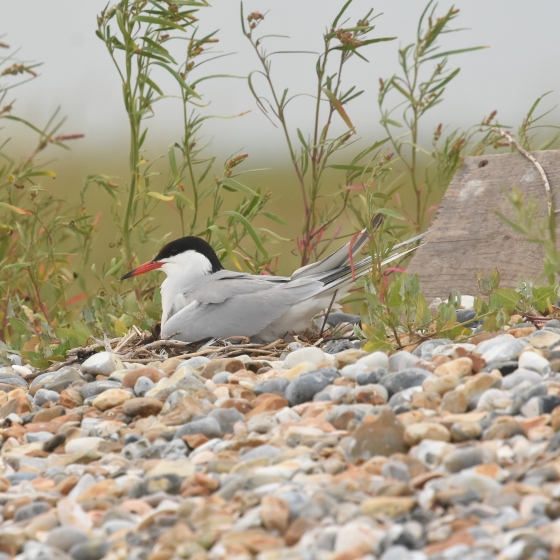
Introduction
This summer visitor to Britain & Ireland is the most familiar of our terns thanks to its habit of inland nesting, a behaviour common across part of its wider range but absent in the larger Scottish colonies.
Common Terns arrive from the middle of April, departing again in late summer for wintering grounds that stretch south from the coast of Spain and around Africa's western seaboard.
While the Common Tern's British breeding range has expanded over recent years – thanks to birds occupying inland waterbodies such as flooded gravel bits – these inland colonies tend to be small, and the gains here contrast with losses at the larger coastal colonies.
- Our Trends Explorer gives you the latest insight into how this species' population is changing.

Key Stats
Identification
ID Videos
This section features BTO training videos headlining this species, or featuring it as a potential confusion species.
Tern Identification Workshop Part 1: Common and Arctic Tern
Songs and Calls
Song:
Call:
Flight call:
Status and Trends
Conservation Status
Population Change
Common Terns breed at lakes and reservoirs scattered across lowland Britain, especially in the major river valleys, and extensively at the coast. There are a few very large coastal colonies and groups of colonies that account for more than half the total population. Breeding numbers and productivity at sample colonies have been monitored annually since 1986 by JNCC's Seabird Monitoring Programme. The abundance trend shows approximate stability from 1986 to 2018 with some small fluctuations, equating to a 9% increase over this period (although this is not statistically significant), while productivity has fluctuated but appears to show a recent decline (SMP data here).
Common Terns are poorly covered by general breeding bird surveys because of their highly aggregated breeding population. There have been enough birds seen on BBS visits for a trend to be drawn but this has an exceptionally wide confidence interval and probably relates mainly to birds seen on overland passage, prospecting for nest sites or breeding in small, dispersed colonies. Extraordinary counts in 2017 and very high counts in 2014 have caused an upturn in the BBS index, but other recent counts have been similar to those from previous years.
Distribution
Breeding Common Terns are widespread and primarily coastal in Scotland and are found on the lochs and islands of the west coast, Outer Hebrides, Northern Isles and around the inner Moray Firth. This contrasts with England, where the species' range is dominated by inland colonies. In Ireland, colonies are more clustered, both on the coast and inland where most nest on islands in the largest lakes.
Occupied 10-km squares in UK
or view it on Bird Atlas Mapstore.
or view it on Bird Atlas Mapstore.
European Distribution Map
Distribution Change
The breeding distribution change map shows a clear pattern of losses in Scotland and Ireland contrasting with gains in eastern and central England since both previous breeding atlases.
Change in occupied 10-km squares in the UK
or view it on Bird Atlas Mapstore.
or view it on Bird Atlas Mapstore.
Seasonality
Common Tern is a summer breeding species, present from April onwards, departing from August onwards.
Weekly pattern of occurrence
The graph shows when the species is present in the UK, with taller bars indicating a higher likelihood of encountering the species in appropriate regions and habitats.

Habitats
Breeding season habitats
Relative frequency by habitat
The graph shows the habitats occupied in the breeding season, with the most utilised habitats shown at the top. Bars of similar size indicate the species is equally likely to be recorded in those habitats.
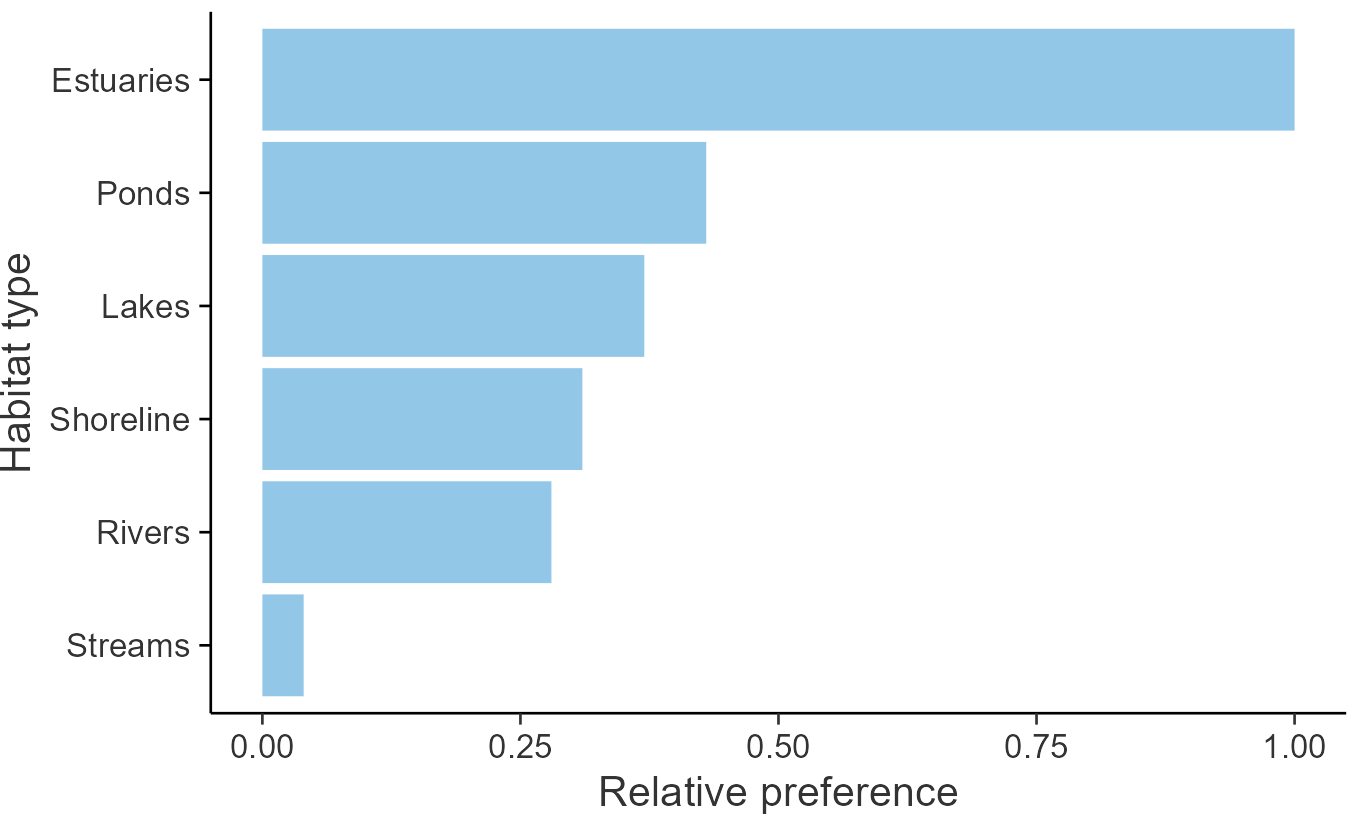
Movement
Britain & Ireland movement
Foreign locations of birds ringed or recovered in Britain & Ireland
Dots show the foreign destinations of birds ringed in Britain & Ireland, and the origins of birds ringed overseas that were subsequently recaptured, resighted or found dead in Britain & Ireland. Dot colours indicate the time of year that the species was present at the location.
- Winter (Nov-Feb)
- Spring (Mar-Apr)
- Summer (May-Jul)
- Autumn (Aug-Oct)

European movements
EuroBirdPortal uses birdwatcher's records, such as those logged in BirdTrack to map the flows of birds as they arrive and depart Europe. See maps for this species here.
The Eurasian-African Migration Atlas shows movements of individual birds ringed or recovered in Europe. See maps for this species here.
Biology
Productivity and Nesting
Nesting timing
Egg measurements
Clutch Size
Survival and Longevity
Survival is shown as the proportion of birds surviving from one year to the next and is derived from bird ringing data. It can also be used to estimate how long birds typically live.
View number ringed each year in the Online Ringing Report.
lifespan
Survival of adults
Survival of juveniles
Biometrics
Wing length and body weights are from live birds (source).
Wing length
Body weight
Ring Size
Classification, names and codes
Classification and Codes
- Order: Charadriiformes
- Family: Laridae
- Scientific name: Sterna hirundo
- Authority: Linnaeus, 1758
- BTO 2-letter code: CN
- BTO 5-letter code: COMTE
- Euring code number: 6150
Alternate species names
- Catalan: xatrac comú
- Czech: rybák obecný
- Danish: Fjordterne
- Dutch: Visdief
- Estonian: jõgitiir
- Finnish: kalatiira
- French: Sterne pierregarin
- Gaelic: Steàrnag-chumanta
- German: Flussseeschwalbe
- Hungarian: küszvágó csér
- Icelandic: Sílaþerna
- Irish: Geabhróg
- Italian: Sterna comune
- Latvian: upes zirinš
- Lithuanian: upine žuvedra
- Norwegian: Makrellterne
- Polish: rybitwa rzeczna
- Portuguese: trinta-réis-boreal / gaivina
- Slovak: rybár riecny
- Slovenian: navadna cigra
- Spanish: Charrán común
- Swedish: fisktärna
- Welsh: Môr-wennol Gyffredin
- English folkname(s): Sea Swallow, Darr, Tirrick
Research
Causes of Change and Solutions
Causes of change
There is little good evidence available regarding the drivers of the breeding population change in this species in the UK.
Further information on causes of change
No further information is available.
Information about conservation actions
The reasons for the declines at coastal colonies are not clear and a wide range of potential conservation actions have been suggested by different authors. These include the control of predators such as rats (Amaral et al. 2010) and gulls (Blokpoel et al. 1997), including selectively controlling chick-predating gulls in Canada (Guillemette & Brousseau 2001); providing plywood shelters for chicks to reduce predation (Burgess & Morris 1992); actions to reduce disturbance such as restricting access to nesting areas (Fasola & Canova 1996) and educating watercraft owners about the effects of disturbance (Burger & Leonard 2000); and habitat management to reduce vegetation (Cook-Haley & Millenbah 2002). In the latter study, vegetation was reduced through spraying and nest success was highest in areas with moderate amounts (40-50%) of vegetation cover.
In Maryland, USA, McGowan et al. (2019) successfully relocated a colony affected by construction work to a new site 200 m away, using a combination of deterrents (overhead lines) at the old site and attractants (audio calls and decoys) at the new site. However, they caution that this approach should only be used when absolutely essential and note that whilst in this case there were no apparent effects on reproduction, this approach may not be viable on all sites.
It is currently unclear which action or actions are most likely to help reverse declines and hence further research may be needed to inform conservation policies. Denac & Bozic (2020) give an account of a wide variety of conservation measures undertaken to provide and enhance breeding habitat for Common Terns in Slovenia, including various actions to manage vegetation, reduce predation and increase nest site availability by preventing Black-headed Gulls from occupying sites (the latter by blocking access until terns had returned using a grid of plastic strings), The success (or failure) of the conservation actions are discussed, although this is largely subjective and the efficacy of the various measures have not been tested experimentally.
Away from coastal sites, the provision of nesting rafts has proved a successful method to attract Common Terns to previously unoccupied inland sites (Dunlop et al. 1991).
Publications (5)
The status of the UK’s breeding seabirds
Author: Stanbury, A.J., Burns, F., Aebischer, N.J., Baker, H., Balmer, D., Brown, A.F., Dunn, T., Lindley, P., Murphy, M., Noble, D.G., Owens, R. & Quinn, L.
Published: 2024
Five seabird species are added to the Birds of Conservation Concern Red List in this addendum to the 2021 update, bringing the total number of Red-listed seabird species to 10, up from six since seabirds were last assessed. The Amber List of seabirds moves from 19 to 14 species, and the Green List increases from one to two species.
29.09.24
Papers
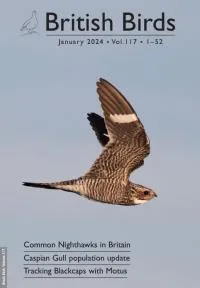
Seabird Population Trends and Causes of Change: 1986–2023
Author: Harris, S.J., Baker, H., Balmer, D.E., Bolton, M., Burton, N.H.K., Caulfield, E., Clarke, J.A.E., Dunn, T.E., Evans, T.J., Hereward, H.R.F., Humphreys, E.M., Money, S. and O’Hanlon, N.J.
Published: 2024
This report presents the latest seabird population trends in breeding abundance and productivity using data from the Seabird Monitoring Programme (SMP).The report documents changes in the abundance and productivity of breeding seabird species in Britain and Ireland from 1986 to 2023, and provides a detailed account of the 2021, 2022 and 2023 breeding seasons.This report includes both inland and coastal populations and trends from the Channel Islands, England, Isle of Man, Northern Ireland, Scotland, Wales and the Republic of Ireland, which are presented where sufficient data are available. The results from this report are used more broadly to assess the health of the wider environment, to inform policy and for conservation action.
21.11.24
Reports Research reports
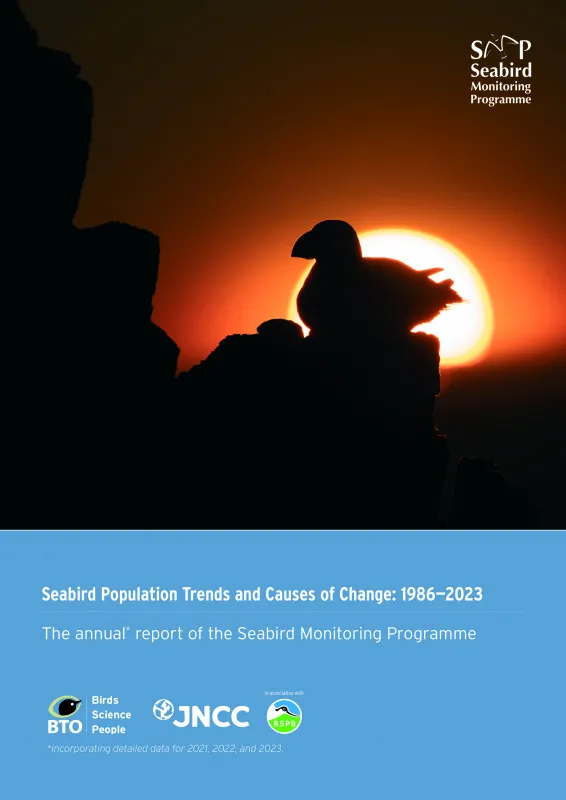
Northern Ireland Seabird Report 2023
Author: Booth, K.J. & El Haddad, H.
Published: 2024
The report includes detailed information about the population trends and breeding success of seabirds in Northern Ireland, over the 2023 breeding season. Notably, Fulmar and Kittiwake populations are reported to be experiencing continued declines, while Guillemot, Common Gull and Herring Gull populations show increases at most breeding sites.
15.04.24
Reports Northern Ireland Seabird Report

Seabird abundances projected to decline in response to climate change in Britain and Ireland
Author: Davies, J.G., Humphreys, E.M., Evans, T., Howells, R., O’Hara-Murray, R. & Pearce-Higgins, J.W.
Published: 2023
Britain and Ireland support globally-important numbers of breeding seabirds, but these populations are under pressure from a suite of threats, including marine pollution, habitat loss, overfishing and highly pathogenic avian influenza. Climate change introduces additional threats, the magnitude of which is uncertain in the future, making it difficult to plan how to apportion conservation efforts between seabird species. Predicting how species’ numbers could change under different climate change scenarios helps clarify their future vulnerability to extinction, and thus assists in conservation planning.
05.12.23
Papers
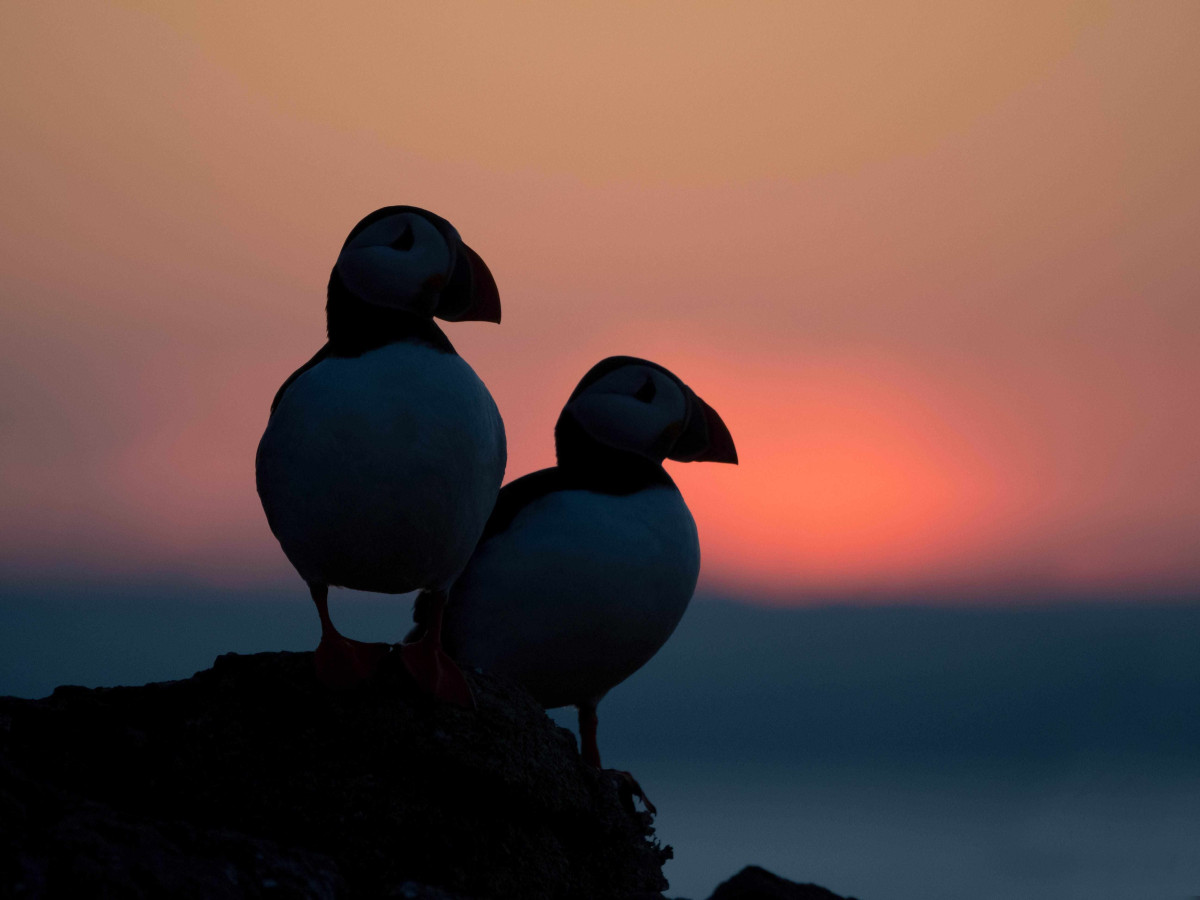
Birds of Conservation Concern Wales 4: the population status of birds in Wales
Author: Johnstone, I.G., Hughes, J., Balmer, D.E., Brenchley, A., Facey, R.J., Lindley, P.J., Noble, D.G. & Taylor, R.C.
Published: 2022
The latest review of the conservation status of birds in Wales. The report assessed all 220 bird species which regularly occur in Wales. There are now 60 species of bird on the Red List, with 91 on the Amber List and just 69 - less than a third of the total number of species - on the Green List.
06.12.22
Reports Birds of Conservation Concern


